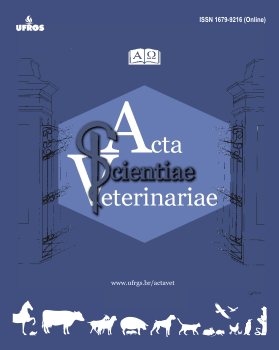Esophageal Squamous Cell Carcinoma in Cats
DOI:
https://doi.org/10.22456/1679-9216.119744Abstract
Background: Esophageal neoplasms are rarely reported in cats. The frequency rate is less than 0.5% and those neoplasms are usually malignant. Esophageal squamous cell carcinoma (SCC) is an idiopathic epithelial neoplasm, invasive and metastatic that can induce partial or complete obstruction of the esophageal lumen. There is no breed or sex predisposition, and it is more common in cats over 8-years-old. Esophageal SCC is more frequent in the middle third of the esophagus. The prognosis is poor, as the cats are usually diagnosed at an advanced stage. This report aims to describe clinical, endoscopic, radiographic, and pathological features of two cases of esophageal squamous cell carcinoma in cats.
Cases: A 11-year-old neutered male cat presenting regurgitation, weight loss, anorexia and dyspnea was referred to veterinary internal medicine care. Simple and contrast-enhanced radiographic images of the cervical and thoracic regions showed an alveolar pattern in the cranial lung lobes and signs of esophageal lumen irregularity and dilatation in the mediastinum topography. The upper digestive endoscopy showed a dilated esophageal lumen, and an irregular mass was observed in the thoracic esophagus involving the entire esophageal circumference. Biopsy fragments were collected, and the histopathological result was compatible with squamous cell carcinoma. The second case was a 10-year-old neutered male cat presenting hyporexia, regurgitation, dyspnea, tachypnea, and abnormal breath sounds. The ultrasound of the chest showed 3 amorphous hypoechogenic and heterogeneous areas in the right and left hemithorax between parietal and visceral pleura. The cytological examination was compatible with a malignant epithelial tumor. The patient died 3 months after the onset of clinical signs. At gross exam, it was observed a friable, irregular, and ulcerated mass of 5.0 x 3.0 cm in the middle third of the esophagus. Metastatic foci in the lungs and liver were also observed. The histopathological diagnosis was esophageal squamous cell carcinoma, with metastases to liver and lungs. Microscopically, in both cases, were seen a
proliferation of polyhedral epithelial cells in the mucosa, arranged in nests or trabeculae with central keratinization. These cells presented oval to rounded nuclei, loose chromatin, prominent nucleolus, and abundant eosinophilic cytoplasm, with marked anisocytosis and anisokaryosis, supported by a thin fibrovascular stroma. In the second cat the neoplastic cells infiltrated the esophageal submucosa, including lymphatic vessels and muscle layer. Lung and liver metastases from the
SCC had a cellular pattern similar to the primary neoplasm.
Discussion: Esophageal squamous cell carcinoma is extremely rare in cats. The SCC begins in the squamous layer of the mucosa and can infiltrate the muscular layer or protrude into the esophageal lumen, leading to clinical signs, as seen in these 2 cats. The differential diagnoses for esophageal SCC include foreign bodies, esophageal strictures, and infiltrative or compressive non-esophageal tumors. Although uncommon, esophageal tumors should be considered when evaluating
elderly cats with regurgitation and weight loss. The diagnosis of esophageal SCC was confirmed by histopathological findings collected endoscopically or during necropsy. As noted in both cases, the prognosis of SCC is generally unfavorable, usually due to the difficulty in treatment and diagnosis in a late stage of the disease.
Keywords: feline, esophagus, neoplasms, metastasis, cancer.
Downloads
References
Berube D., Scott-Moncrieff J.C., Rohleder J. & Vemireddi V. 2009. Primary esophageal squamous cell carcinoma in a cat. Journal of the American Animal Hospital Association. 45(6): 291-295.
Fernandes F.H., Hawe R.S. & Loeb W.F. 1987. Primary squamous cell carcinoma of the esophagus in a cat. Companion Animal Practice. 1: 16-20.
Gualtieri M., Monzeglio M.G. & Di Giancamillo M. 1999. Oesophageal squamous cell carcinoma in two cats. Journal of Small Animal Practice. 40(2): 79-83.
Gualtieri M. & Olivero D. 2006. Reflux esophagitis in three cats associated with metaplastic columnar esophageal epithelium. Journal of the American Animal Hospital Association. 42: 65-70.
Happé R.P., van der Gaag I., Wolvekamp W.T.C. & Van Toorenburg J. 1978. Esophageal squamous cell carcinoma in two cats. Tijdschr. Diergeneesk. 103(20): 1080-1086.
Jergens A. 2005. Diseases of the esophagus. In: Ettinger S. & Feldman E. (Eds). Textbook of Veterinary Internal Medicine. 6th edn. Philadelphia: Elsevier Saunders, pp.1307-1308.
Munday J.S., Löhr C.V. & Kiupel M. 2017. Tumors of the Alimentary Tract. In: Meuten D.J. (Ed). Tumors in Domestic Animals. 5th edn. Ames: Wiley Blackwell, pp.499-601.
Ridgway R. & Suter P. 1979. Clinical and radiographic signs in primary and metastatic esophageal neoplasms of the dog. Journal of the American Animal Hospital Association. 174: 700704.
Turner J.R. 2016. O trato gastrointestinal. In: Kumar V., Abbas A.K. & Aster J.C. (Eds). Robbins & Cotran Patologia - Bases Patológicas das Doenças. 9.ed. Rio de Janeiro: Elsevier, pp.1358-1495.
Twedt D.C. 1995. Diseases of the oesophagus. In: Ettinger S.J. & Feldman E.C. (Eds). Textbook of Veterinary Internal Medicine. 4th edn. Philadelphia: W.B. Saunders, pp.1140-1141.
Withrow S.J. 2001. Oesophageal cancer. In: Withrow S.J. & MacEwen E.G. (Eds). Small Animal Clinical Oncology. 3rd edn. Philadelphia: W.B. Saunders, pp.320-321.
Published
How to Cite
Issue
Section
License
Copyright (c) 2022 Mary Suzan VARASCHIN

This work is licensed under a Creative Commons Attribution 4.0 International License.
This journal provides open access to all of its content on the principle that making research freely available to the public supports a greater global exchange of knowledge. Such access is associated with increased readership and increased citation of an author's work. For more information on this approach, see the Public Knowledge Project and Directory of Open Access Journals.
We define open access journals as journals that use a funding model that does not charge readers or their institutions for access. From the BOAI definition of "open access" we take the right of users to "read, download, copy, distribute, print, search, or link to the full texts of these articles" as mandatory for a journal to be included in the directory.
La Red y Portal Iberoamericano de Revistas Científicas de Veterinaria de Libre Acceso reúne a las principales publicaciones científicas editadas en España, Portugal, Latino América y otros países del ámbito latino





